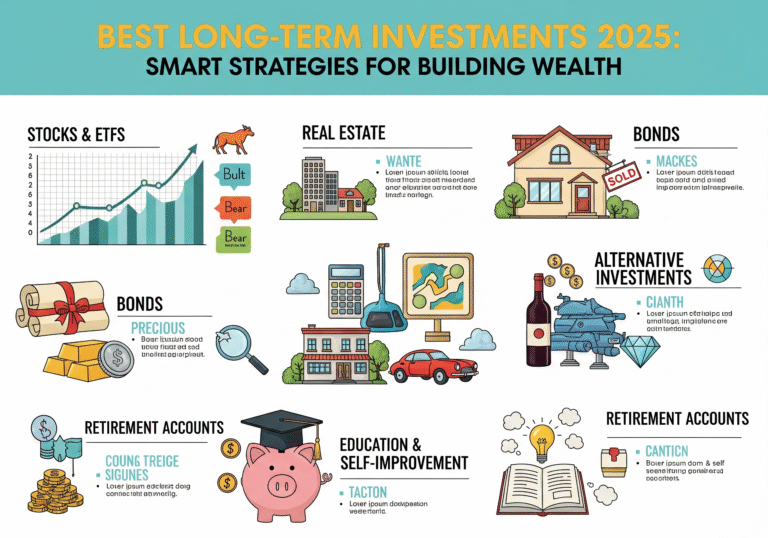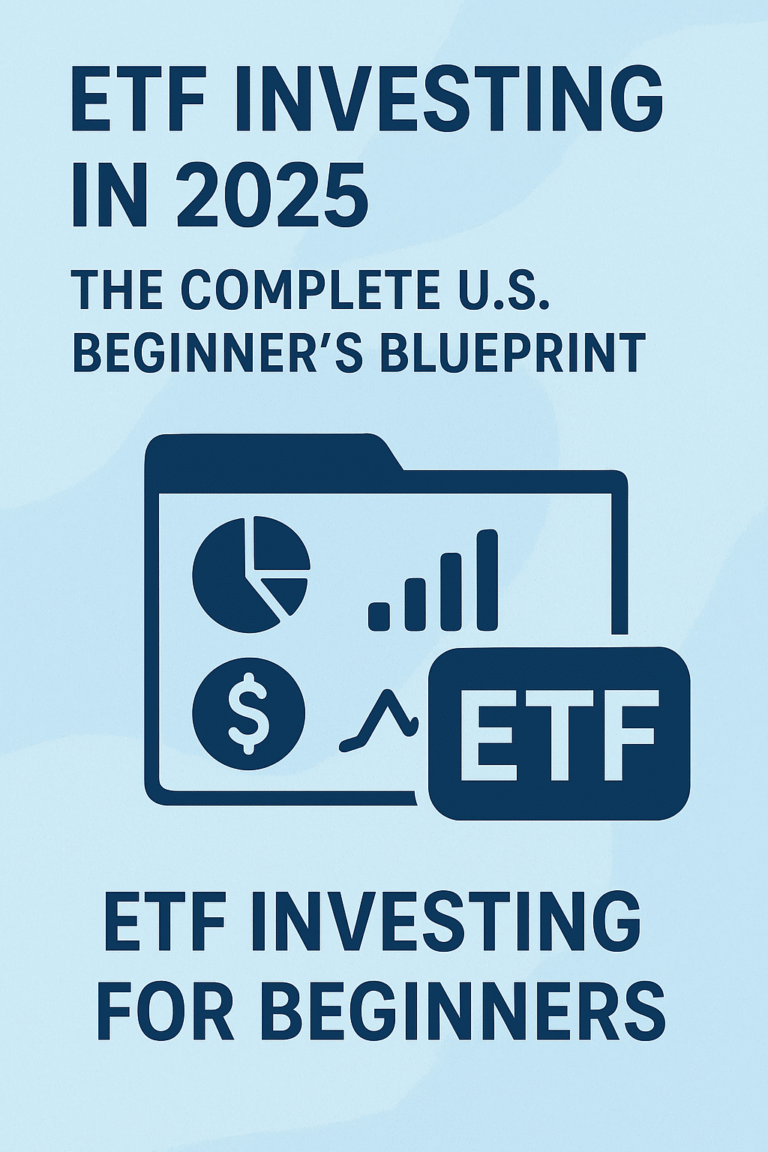Tax-Efficient Investing U.S. 2025 — Smart Strategies
Tax-Efficient Investing U.S. 2025

Introduction Of Tax-Efficient Investing in the U.S. 2025
The majority of novices who invest in the United States simply consider returns. However, seasoned investors are aware that taxes can stealthily reduce your earnings. For this reason, one of the best strategies to increase wealth in 2025 is through tax-efficient investing. You can lawfully keep more of your money if you know how to use tax-advantaged accounts, make wise investment choices, and use clever withdrawal techniques.
The top tax-efficient investment techniques for American investors in 2025 will be discussed in this guide, which is intended primarily for novices who wish to increase their wealth while lowering their tax obligations.
Why Tax Efficiency Matters in 2025 AND Tax-Efficient Investing U.S. 2025
Investors that prepare ahead are rewarded by the U.S. tax system. Think about this:
- You could lose 20–30% of your federal and state taxes if you invest $100,000 and don’t employ tax-efficient tactics.
- However, you may save thousands of dollars annually by using accounts like HSAs, 401(k)s, and Roth IRAs wisely.
In 2025, retaining more of your earnings is just as crucial as generating larger returns due to inflation, growing healthcare expenses, and unpredictable market conditions.
1.Use Tax-Advantaged Accounts First
Beginners should concentrate on tax-advantaged accounts before investing in taxable brokerage accounts. Either tax-free growth, tax-deferred growth, or upfront tax savings are possible with these accounts.
A)Plans for 401(k)s
- retirement plan funded by the employer.
- Your taxable income is reduced today since contributions are tax deductible.
- A lot of firms provide a match, which is free money you shouldn’t pass up.
For instance, you will immediately have $9,000 invested if you contribute $6,000 and your company matches $3,000.
B) A Roth retirement account
- After-tax funds are used to make contributions.
- In retirement, withdrawals are completely tax-free.
- Excellent for youthful investors who anticipate eventually being in a higher tax rate.
C) The HSA (Health Savings Account)
- The “triple tax advantage account” is a common term.
- Tax deductions are available for contributions.
- Growth is exempt from taxes.
- Medical expenditure withdrawals are tax-free.
- You can utilize HSA funds for anything (like a standard IRA) beyond the age of 65.
👉 Pro Tip: Before switching to taxable accounts, make sure you max out your HSA and Roth IRA in 2025.
2.Hold Investments in the Right Accounts (Asset Location)
The taxation on investments varies. Asset location is the process by which astute investors choose which assets to hold in which accounts.
- Index funds, exchange-traded funds, and municipal bonds are examples of tax-efficient investments that perform best in taxable accounts.
- Investments that are tax inefficient (such as actively managed funds, REITs, and high-dividend equities) are best placed in retirement accounts like IRAs or 401(k)s.
For instance, dividends from a REIT held in a taxable account are subject to ordinary income tax. However, dividends grow tax-free if you own the same REIT in a Roth IRA.
3. Understand Capital Gains Taxes
Long-term investments are still encouraged by capital gains tax rates in 2025.
- Capital gains that are sold within a year are subject to ordinary income tax, which can reach 37%.
- Lower rates (0%, 15%, or 20%) apply to long-term capital gains (kept for more than a year).
👉 Takeaway: You pay less in taxes the longer you own investments. Profit comes from patience.
4.Tax-Loss Harvesting
Investors can use tax-loss harvesting to offset taxable gains by selling failing investments.
- You only have to pay taxes on the $2,000 net gain if you made $5,000 from one stock but lost $3,000 from another.
- Losses from investments can also offset up to $3,000 of regular income annually.
Tax-loss harvesting for novices is automated by platforms such as Wealthfront, Betterment, and Fidelity.
5.Dividend and Interest Income Planning
According to the IRS, not all dividends are created equal.
- Dividends that qualify are subject to reduced long-term capital gains taxes.
- Ordinary interest and dividends are subject to ordinary income tax rates.
👉 To lower taxes, select index funds and tax-efficient exchange-traded funds (ETFs) that offer eligible dividends.
6.Smart Withdrawal Strategies in Retirement and Tax-Efficient Investing U.S. 2025
When you quit your job, tax efficiency becomes even more critical.
- Take money out of taxed accounts first.
- Next, make use of tax-deferred accounts (traditional IRA, 401k).
- Because it grows tax-free indefinitely, save your Roth IRA until last.
This order guarantees long-term tax efficiency while assisting in the reduction of Required Minimum Distributions (RMDs).
7.State Taxes and Residency Considerations and Tax-Efficient Investing U.S. 2025
State taxes may have an equal or greater impact than federal taxes.
- States with no state income tax, such as Florida, Texas, and Nevada, are excellent places to retire.
- States with high tax rates, such as California and New York, may reduce the returns on your investments.
It can make sense to hold more investments in taxable accounts now if you intend to retire in a place with no taxes.
8.ETFs vs Mutual Funds for Tax Efficiency
ETFs (exchange-traded funds) continue to be more tax-efficient than mutual funds in 2025 due to their “in-kind redemption process,” which prevents capital gains from being triggered.
👉 Novices should focus on inexpensive index ETFs such as:
- Vanguard Total Stock Market ETF, or VTI and
- Tax-Efficient Investing U.S. 2025, or VOO
- Total International ETF, or VXUS
9.Charitable Giving for Tax Benefits and Tax-Efficient Investing U.S. 2025
Being generous can lower your taxes.
- You can avoid capital gains and receive a tax benefit by donating valuable shares.
- For optimum impact, high-net-worth investors frequently use donor-advised funds (DAFs).
To save more, even novices can donate ETF shares rather than cash.
10.Avoid Common Tax Mistakes Beginners Make
- Trading too much (generates short-term capital gains).
- Not maxing out retirement accounts.
- Holding tax-inefficient funds in taxable accounts.
- Forgetting about state tax impact.
Conclusion Of Tax-Efficient Investing U.S. 2025
The goal of tax-efficient investment is to keep a larger portion of your earnings lawfully, not to completely avoid taxes. U.S. investors in 2025 might significantly accelerate the development of long-term wealth by utilizing tax-advantaged accounts, putting investments in the appropriate locations, comprehending capital gains, and putting astute tactics into practice.
Recall that what matters is how much you keep, not how much you earn.
how-to-build-a-diversified-investment-portfolio
asset-finance-solutions-explained








2 Comments